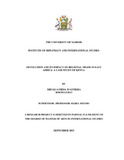| dc.contributor.author | Mbugua, Frida W | |
| dc.date.accessioned | 2016-04-28T14:18:07Z | |
| dc.date.available | 2016-04-28T14:18:07Z | |
| dc.date.issued | 2015 | |
| dc.identifier.uri | http://hdl.handle.net/11295/95299 | |
| dc.description.abstract | The new devolved system of government in Kenya, though viewed by many as a political step to decentralize power; it is actually an economic tool for the country to spur economic development in order to reap the full benefits of liberalized trade within a regional integration setting.
Kenya‟s main objective of adopting a devolved system of Government was to bring services closer to the people and enhance development through development friendly legislation and policies. It was anticipated that with devolution as a key development tool, the country‟s economy would grow and the cost of doing business would go down because the services would be closer to the people.
Two years into Devolution, the regional traders are confronted with multiple taxes while traversing counties in Kenya. They are forced to pay identical charges and levies in each of these counties or in other situations make payment to the national Government and to County Governments for concurrent services or no services at all in some instances. This multiplicity is not only affecting the intra-county trade in Kenya but also trade within the EAC at large. In raising an alarm on the multiple taxes, fees and charges in the new devolved system and their effect on intra EAC trade, Tanzania reported Kenya to the EAC in 2013 as having introduced non tariff barriers (NTBs) through the levies charged by the counties in total disregard of Kenya‟s obligations in the EAC.
This research reviews devolution in Kenya and its impact on EAC regional trade and also suggests suitable measures to address the existing challenges. | en_US |
| dc.language.iso | en | en_US |
| dc.publisher | University of Nairobi | en_US |
| dc.rights | Attribution-NonCommercial-NoDerivs 3.0 United States | * |
| dc.rights.uri | http://creativecommons.org/licenses/by-nc-nd/3.0/us/ | * |
| dc.title | Devolution And Its Impact On Regional Trade In East Africa: A Case Study Of Kenya | en_US |
| dc.type | Thesis | en_US |



